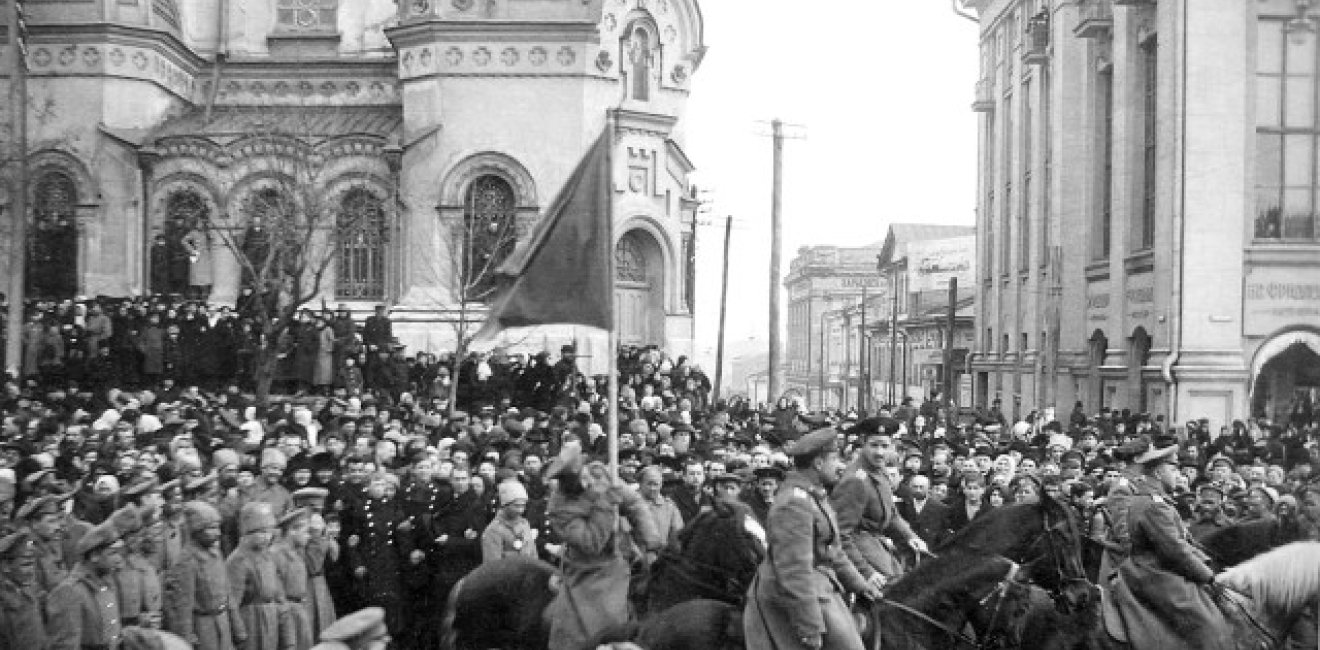
A blog of the Kennan Institute
A century ago, revolution broke out in the Russian Empire. The first step was taken in February 1917, when the monarchy fell and a republic was instituted. The second major event in the revolutionary drama was connected with the takeover of the Winter Palace by the Bolsheviks in October 1917. And the third major act was the dissolution of the Constituent Assembly—the elected representative body that was to establish a republic in its constitutional form—by the Bolsheviks in January 1918. With these steps, the possibility of a more or less smooth transition of power was hopelessly destroyed, and for the next five years violence and chaos reigned among huge populations living between the Baltic Sea and the Pacific Ocean and between the Arctic Ocean and the Pamir Mountains.
In the West, these events are usually referred to as the “Russian revolution.” And there are good arguments in favor of this term. The events took place in the lands then under the control of the Russian Empire, and the significant revolutionary events listed above took place in the Russian capitals of Petrograd and Moscow.
For other revolutionary events also were taking place in the lands of the former Russian Empire between 1917 and 1924 and are rendered invisible if the underlying framework remains Russian.
However, “Russian revolution” is not a sufficient name. For other revolutionary events also were taking place in the lands of the former Russian Empire between 1917 and 1924 and are rendered invisible if the underlying framework remains Russian. Indeed, the term encompasses two different revolutions, with different goals and characteristics, that unfolded in many more societies than just the Russian context.
To explain what is occluded by use of the name Russian revolution, I should first recall what a revolution is.
Humanity today has accumulated a vast—four or five centuries-long—experience in launching revolutions, as well as in surviving them and in healing revolution-caused traumas. The Age of Great Revolutions started with the huge colonial projects of Spain and Portugal, the European Reformation, and the British Revolution—that is, in the sixteen and seventeenth centuries. Proceeding chronologically from that era through the American (1765–1783), French (1789–1799), Russian (1917–1924), and Chinese (1946–1950) revolutions to the “conservative,” “velvet,” and “color” revolutions of recent years, humankind has gained bittersweet experience in building new worlds, changing them radically, and adapting to their aftermaths.
Based on this experience, a modern revolution should be defined as a time and space where human creativity leads to the establishment of new political and socioeconomic orders, where history starts anew. This is why the twentieth-century political philosopher Hannah Arendt called a revolution a moment of new beginnings and unlimited political creativity of modern men and women (see her On Revolution, chapter 1).
From a historian’s perspective (be it that of Georg Hegel, Karl Marx or Shmuel Eisenstadt), revolutions are periods of rapid change leading to a change of political regime (punctuated with symbolic acts such as a monarch’s execution or the liberation of prisoners) and a simultaneous change in understanding of the legitimacy of the established political order, resulting in the spawning of some distinct cosmologies, as well as distinct cultural and political programs.
Even though these two major views on revolution differ in their assessment of the radicalism of the transformation, they have in common attention to the revolutionary creativity of new orders and violence against everything embodying the past.
Whichever standpoint you accept, it is critical to see as the core thought the rapid change spreading throughout a society at large, rather than confined to a destroyed center. To a student of revolutions, the outburst of political creativity and the establishment of new political forms and orders are fascinating to monitor.
And this is why the whirlwind of events in Eastern Europe in 1917–1924 cannot be understood if one focuses only on the Russian dimension of this revolutionary period. The February revolution launched the process of establishing republics in Eastern Europe. During the revolutionary period, republics (as independent polities or federal unions) were established in Russia (1917), Finland (1917), Estonia (1918), Latvia (1918), Lithuania (1918), Poland (1918), Ukraine (1918), Moldova (1917), Georgia (1918), Armenia (1918), and Azerbaijan (1918). This Eastern European republican impulse also extended into the lands of northern Eurasia, namely, Turkestan and Siberia. The history of experiments with nation-states, republics, constitutional democracy, and national economies starts then and there. Attempts were made through these revolutionary processes to shape new societies, polities, and economies. And the plurality of these processes exceeds the relatively limited name of Russian revolution.
The October revolution launched another practice. Here the socialist revolution had an even more ambitious aim: to experiment with a classless society and a no-private-property economy and state under the control of a single party (which was expected to prevent recidivism into bureaucracy and political competition). Grounded in hopes for an alternative to ethnonationalism and bourgeois democracy, socialist revolutions took place not only in Russia, Ukraine, Finland, and some other former territories of the Russian Empire in 1917–1918 but also in countries such as Germany and Hungary in 1918.
The socialist revolution continued in Central Europe and eastern Eurasia. The Stalinist USSR established the social Eastern Bloc in Europe. China, Korea, Vietnam, Cuba, and Cambodia each underwent their own socialist revolution. With the dissolution of empires in the second half of the twentieth century, socialist revolutions took place around the globe. And this tendency toward world proletarian revolution, though it started in the lands of the former Russian Empire, cannot accurately be called Russian.
Revolutionary experiments with nation-states, democracy, and a market economy keep emerging and pushing forward.
Together, the republican and socialist revolutions launched the historical trajectories of the societies of Eastern Europe and northern Eurasia in the twentieth century. The fall of the Eastern Bloc and the dissolution of the USSR have brought the agenda of the February revolution back to most of the post-Soviet and postsocialist societies. Revolutionary experiments with nation-states, democracy, and a market economy keep emerging and pushing forward. However, the impact of the socialist October revolution remains highly influential—though activities surrounding its remembrance are often officially prohibited and negated—in almost all societies of the region.
Nonetheless, for none of these revolutionary traditions, either of the February or of the October kind, is the term “Russian revolution” adequate. It simply misses the many points of political creativity and destruction, past and present, in the lands of Eastern Europe and northern Eurasia.
Author


Kennan Institute
After more than 50 years as a vital part of the Wilson Center legacy, the Kennan Institute has become an independent think tank. You can find the current website for the Kennan Institute at kennaninstitute.org. Please look for future announcements about partnership activities between the Wilson Center and the Kennan Institute at Wilson Center Press Room. The Kennan Institute is the premier US center for advanced research on Eurasia and the oldest and largest regional program at the Woodrow Wilson International Center for Scholars. The Kennan Institute is committed to improving American understanding of Russia, Ukraine, Central Asia, the South Caucasus, and the surrounding region through research and exchange. Read more

Explore More in Focus Ukraine
Browse Focus Ukraine
Talking to the Dead to Heal the Living

Ukrainian Issue in Polish Elections


